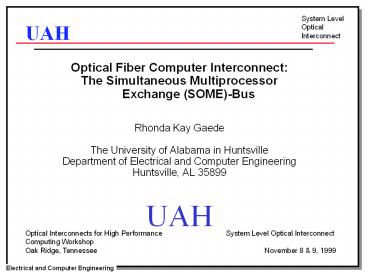Optical Fiber Computer Interconnect: PowerPoint PPT Presentation
1 / 18
Title: Optical Fiber Computer Interconnect:
1
- Optical Fiber Computer Interconnect
- The Simultaneous Multiprocessor
- Exchange (SOME)-Bus
- Rhonda Kay Gaede
- The University of Alabama in Huntsville
- Department of Electrical and Computer Engineering
- Huntsville, AL 35899
- UAH
Optical Interconnects for High Performance
System Level Optical
Interconnect Computing Workshop
Oak Ridge, Tennessee
November 8 9, 1999
2
Disciplines
- Optical Engineering
- Electrical Engineering
- Computer Engineering
3
Outline
- Computer Networks
- Electronic and Optical Technologies
- SOME-Bus Architecture
- Optics and Electronics Implementations
- Programming Support
- Future Work
- Conclusions
4
Computer Networks
- Carries information between processors
- Influences computer system performance
- Many Variations
- Shared Bus
- Point-to-Point
5
Shared Bus
- Single set of wire(s) used for data exchange,
e.g. Ethernet segment - Advantages
- Low wiring costs
- Direct connection between processors
- Disadvantages
- Limited communication bandwidth
- Arbitration overhead
6
Point to Point
- Dedicated sets of wires used between pairs of
processors - Advantages
- Greater aggregate bandwidth
- Limited number of taps on channel
- Disadvantages
- More wiring
- Processors not directly connected
7
Electronics Technology
- Advantages
- Dense digital VLSI circuitry
- Inexpensive fabrication
- Disadvantages
- Low fan-out of signals
- Low bandwidth per channel
- Point-to-point communication channels
8
Optics Technology
- Advantages
- High fan-out of signals
- High bandwidth per channel
- Multi-cast communication channels
- Disadvantages
- Single point insertion
- Weak computing facilities
9
SOME-Bus Architecture
- Exploits strengths of electronics and optics
technologies - One dedicated unidirectional channel per
processor - Each processor observes all channels
- Performance not limited by communication medium
(fiber)
10
Network Characteristics
11
Optics Implementation
- Ribbon of multiple optical fibers
- Input coupler
- One per fiber
- Multiple wavelengths of light
- Multiple processor channels on single fiber
- Output coupler
- Multiple output couplers per fiber
- Bragg grating in fiber
- Wavelength specific
- Very small output per grating (1)
- Aligned with optical detectors
12
SOME-Bus Implementation
13
Electronics Interface
- Integrated Circuit (IC)
- Array of receivers
- Interface to Processor bus
- 128 1024 byte buffers and associated logic fit in
a die size of 1.6 cm x .8 cm - Receiver Functions
- Convert optical detectors analog signal into
digital signal - Filters out uninteresting bus traffic
- Buffer data until processor bus available
14
Programming Support
- Communication models
- Shared memory
- Message passing
- Simplified model for programming
- Direct connections between processors
- No interference on channel from other processors
- High-speed broadcast
- Fast barrier synchronization mechanism
15
Factors Affecting Performance
- Bandwidth is an important concern, but not the
only one - Latency is critical in many computer operations
such as - Cache coherency messages
- Shared memory data exchanges
- Handshaking and synchronization signals
- Network flow control/resource allocation
16
Future Work
- Form gratings in fibers and characterize
footprint and selectivity - Examine issues of inter-mixed analog and digital
circuitry - Build silicon v-groove devices to hold fibers for
alignment with photodetectors - Characterize performance for realistic program
loads using simulations. - Investigate whether diffractive optic elements
are required, build if necessary - Build and characterize 32 channel prototype
17
Conclusions
- Bandwidth scales with the number of processors
- Network diameter 1
- Supports shared memory, message passing and
synchronization - As technology matures, the system bandwidth will
increase
18
Receiver Front End Logic

